Automation is heard everywhere today, and there’s basically no niche that would radically resist its implementation anymore. This buzz and increasing adoption don’t come out of nowhere – thanks to technological advancements, AI business process automation is implemented in shorter and cheaper timeframes than ever before. Improvements once reserved for the largest market players are now achievable for companies of all sizes without investing huge funds.

Automation itself means something entirely different today than it did just a few years ago. Artificial intelligence has changed the approach to its implementation, enabling maximal use of data for process optimization. With the democratization of generative artificial intelligence, AI business process automation possibilities are greater than ever. Instead of relying on predefined scenarios, GenAI handles individual prompts and automates tasks that require creativity, not just processing. Thus, understanding the difference between AI and Gen AI and using it in practice is essential to successful AI automation today.
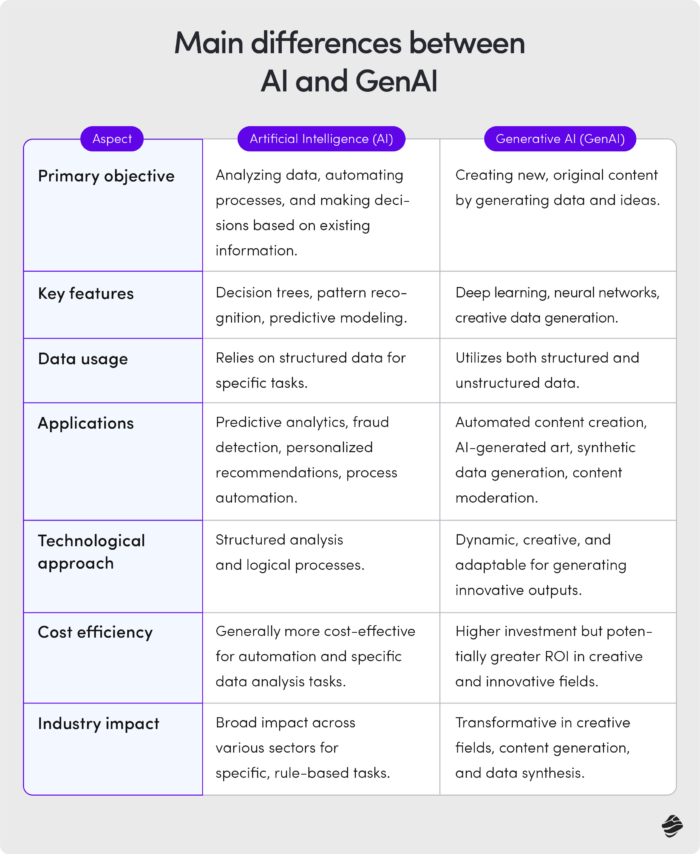
Which processes can be automated, which are worth it, and how to do it smartly? These are the aspects that experts participating in a recent webinar organized by Miquido, focusing on Generative AI in enterprise processes, have examined closely. Cristina Duta, Lars Rinnan, Gabriel Skelton, and Jerzy Biernacki broke down various aspects of automation, and this article delves into the crucial takeaways from their insights.
Key Benefits of AI for Business Process Automation and How to Reach Them
The benefits of AI business automation vary depending on which processes or issues are targeted. However, there are several benefits that most companies can achieve, regardless of the nature of their business.
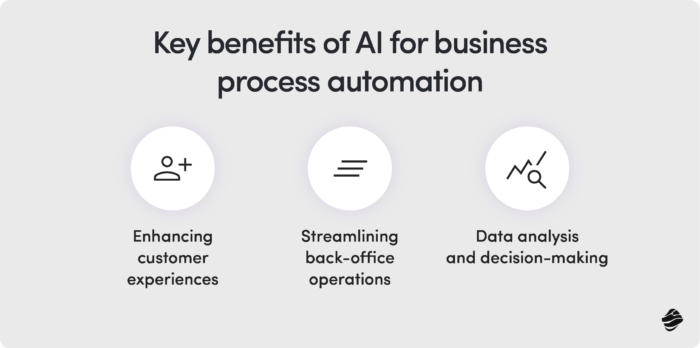
Enhancing Customer Experiences
Thanks to the development of generative artificial intelligence, customer support is much more effective than ever. GenAI can respond directly to prompts rather than forcing the customer to follow a scripted scenario, making the interaction more efficient and natural. That makes customer service optimization one of the most applied generative AI use cases in business today.
However, it also proves highly beneficial for internal needs, supporting HR onboarding, as illustrated by Cristina Duta’s example. Her team tackled onboarding inconsistencies by implementing a chatbot with GenAI capabilities across various communication channels, including emails, voice, and messaging platforms. This seamless onboarding experience guides users through tasks, provides relevant documents based on provided information, answers FAQs, conducts surveys for feedback, and continually improves user experience.
Streamlining Back-Office Operations
Most back-office tasks, from document processing and invoicing to data entry, can be optimized with AI, reducing errors and freeing up employees for higher-value work. As advised by Cristina Duta, in order to minimize inaccuracies, it’s crucial to fine-tune the process to extract only relevant data and focus on documents with typed text when implementing AI.
To maximize your chances for precise results, analyze which fields and documents yield the most accurate results to maximize ROI. Finding a balance between flexibility and accuracy is key, especially when addressing complex questions not explicitly stated in documents.
Data Analysis and Decision-Making
Data is modern gold, and companies have an increasing amount of it at their disposal. However, it’s not about how much of it you have, but how you use it. With AI, relevant insights can be extracted from vast datasets that would be impossible for human minds to grasp with limited processing capabilities.
Lars Rinnan’s case study on automating end-of-project processes illustrates the capabilities of AI in this field. By implementing GPT-4 within the secure Azure OpenAI service, along with prompt engineering and a Python-based PDF parser, his team radically streamlined document processing, making the generation of 300 extensive reports a month a matter of few clicks.
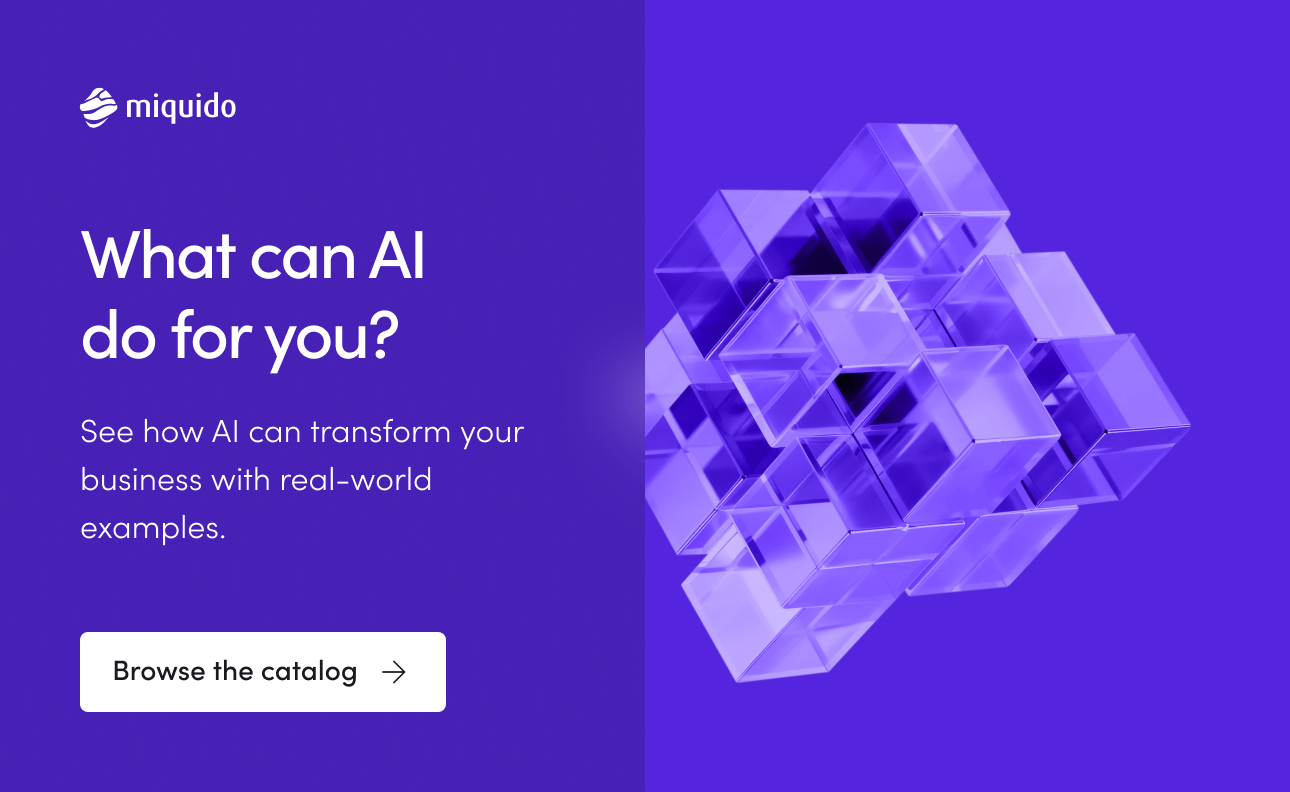
Overcoming Implementation Challenges: How to Make Your AI Business Process Automation a Success Story?
AI and GenAI are not the magic quick fix, but having these good practices in mind, you can make the most of your AI business automation and turn it into actual success. From strategic planning through data utilization to mindset and motivation, here’s what our experts recommend.
Automate the core processes
Many companies start by automating the administrative and support side, but the biggest ROI lies in the core processes. Sales support, prospecting, business analysis, quality assurance, forecasting – don’t hesitate to delve into these areas with automation, while maintaining an attitude of “supporting, not replacing.” Your team will still be there to handle the most challenging tasks – but they will have an invaluable assistant that never gets tired and maintains the same accuracy over time.
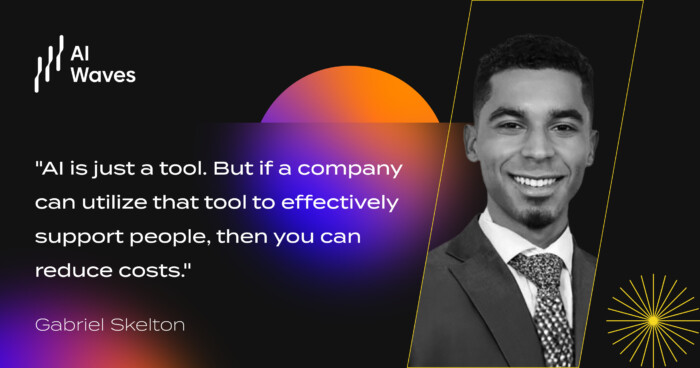
Prepare for the worst
When dealing with processes involving operations across regions and teams, begin by identifying potential challenges. Outline worst-case scenarios, taking into account factors such as legal complexities, risk assessments, legacy systems or language barriers. As Gabriel Skelton suggests, starting from these worst-case scenarios allows you to develop solutions systematically, building upon this foundation. Such approach enables you to confront challenges directly upfront and create robust solution using AI for business automation.
Start Automating Without Waiting for Problems to Arise
Your company may be functioning well, but it can always function even better. Implementing AI doesn’t necessarily have to solve a specific problem because you may not have one at the moment – it could simply streamline, improve, and make the work environment friendlier.
Think of BlackBerry and Apple – once nobody could imagine a world without BlackBerry until the iPhone with its touchscreen appeared. Did it solve a specific problem? No, but suddenly performing many tasks on the phone became faster and easier. This seemingly small change had a gigantic impact on the global trajectory of technology. Similarly, you can make a big difference at your company with a small automation project.
Avoid Hallucination with Verified Techniques
Both RAC and fine-tuning can reduce hallucinations almost to a level of non-existence. In the case of Retrieval augmented generation (RAG), generating responses by an AI model is supported by up-to-date factual documents that can answer specific questions you have. This complements LLM and enables companies to effectively automate without the need for “fact-checking” and continuous database updates regarding policy changes and other aspects.
Fine-tuning also reduces the risk of hallucinations, as confirmed by the use case of Morgan Stanley and GPT-4 brought up by Lars. The company fine-tuned the large language model based on almost every analysis it’s ever done a few years back, and the level of accuracy exceeded its expectations. They managed to create an interface that serves 75,000 employees worldwide in quickly obtaining accurate information.
Just Start – It’s Easier Than Ever
AI projects used to be multi-year, multi-million-dollar endeavors. Now, they can be completed in weeks or months for each use case, with significantly reduced costs and barriers to entry. Start small, gain valuable experience and scale up gradually, cultivating good data practices. Don’t let the risk aversions stop you.
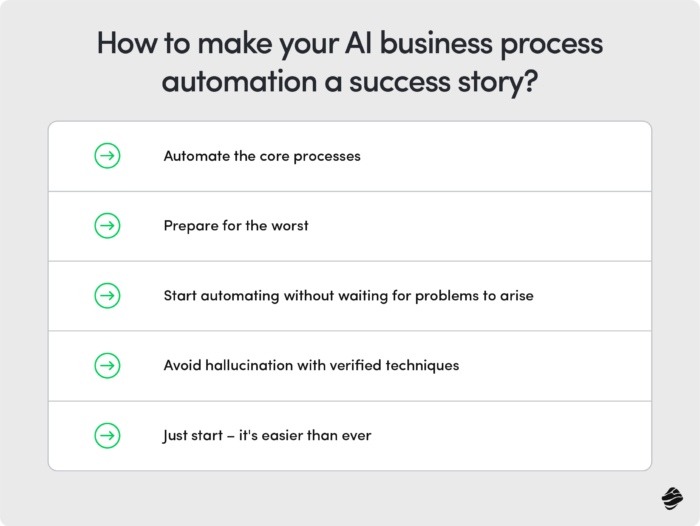
AI Automation for Businesses and Its Impact Across Industries
From banks through e-commerce to supermarkets, the benefits of AI automation can reach every company operating on data and repetitive processes. However, there are sectors where its advantages are most visible and best illustrate potential improvements.
Healthcare
AI in healthcare has immense potential, especially in terms of natural language processing and document processing. Think about faxing – you probably consider this technology obsolete, right alongside pagers and typewriters, but the fax machine is still a king in the healthcare sector. This is primarily due to regulatory requirements like HIPAA/GDPR/PIPEDA compliance and the lack of interoperability between different electronic medical record systems.
You might ask – why to fix something that is not broken? Primarily because this solution has more drawbacks than benefits. This reliance on fax machines translates to extensive paper usage, requiring personnel to do tons of manual, repetitive work to ensure accuracy. Inaccuracies occurring in this process can have severe consequences for patient care.
GenAI opens new possibilities in this area by eliminating the limitations of traditional OCR. With it, medical facilities can quickly extract necessary data from extensive, unstructured documents. They can use general AI to extract complex data from a document and then input it into the electronic medical record (EMR) system using simple bot automation technology. Integrating existing systems with new technology, like derivative AI, can lead to substantial efficiency gains.
Manufacturing
Due to inherent working conditions and potential risks to worker safety, manufacturing is a perfect ground for automation efforts. One significant aspect is the reduction in the need for human presence during shifts. By leveraging AI for business process automation, you can optimize production schedules without compromising worker health.
Additionally, AI can help prevent equipment breakdowns caused by fatigue-induced errors in maintenance testing. It also allows for the automation of tasks in hazardous environments, reducing the need for prolonged human exposure to risks. This shift towards technology-driven safety measures aligns with prioritizing worker well-being.
Non-Governmental Organizations
AI can also be used for good, as the use case of the International Federation of Red Cross and Red Crescent Societies brought up by Lars proves. Back during the pandemic in 2020, the organization struggled to handle the increasing influx of reports with their manual tagging and prioritization process. Seeking automation to handle the volume, they developed a system that could automate the tagging of reports, regardless of language, with a high level of accuracy, around 86-87%.
This automated system streamlined their response efforts during the pandemic, allowing them to prioritize aid and resources effectively. The success of this project led them to embrace natural language processing (NLP) technology further.
The Red Cross solution inspired two AI for Good projects, one of them assisting people in the aftermath of the Turkey earthquakes and the other linking Ukrainian refugees with hosts while solving language barriers. Other organizations could follow these initiatives, eliminating manual work associated with processing applications and their prioritization. AI process automation could also enable them to offer communities new forms of support that don’t require volunteers to be present on-site. And as a result – do even more good!
AI for Business Process Automation – Ethical Considerations and Bias Mitigation
The development of AI in recent years has accelerated so much that regulatory frameworks have been unable to keep up. In our professional and personal lives, we suddenly gained access to tools that cannot be held accountable. Biases in training data can perpetuate unfair outcomes and reinforce societal inequalities. Therefore, it is crucial for the implementation of these technologies to be under human oversight, utilizing audits and algorithmic adjustments as bias mitigation techniques.

Cristina Duta’s example of AI companions highlights the profound impact algorithms can have on human life. While it’s challenging to anticipate all consequences, ethical considerations should be integrated into the design process to mitigate risks. Strategies like data cleaning, validation, and algorithm transparency help address ethical concerns, but ongoing education and vigilance are essential in navigating the evolving landscape of AI.
Wrap Up: 5 Key Takeaways from AI Waves
As you can see, our experts have discussed AI for business process automation from various different angles. It’s worth delving into their insights thoroughly, but here’s the summary of the key conclusions drawn from their conversation.
- Generative AI revolutionizes automation by handling individual prompts and tasks requiring creativity, not just processing, thereby expanding automation possibilities.
- Sectors like healthcare, manufacturing, and NGOs benefit significantly from AI automation, addressing challenges such as document processing, safety, and response efficiency. And so can your business, regardless of its industry!
- When implementing AI in business, start by identifying problems, imagine the worst that could happen, and then build solutions step by step to tackle them head-on.
- Effective utilization of techniques like Retrieval augmented generation (RAC) and fine-tuning significantly diminishes AI model hallucinations, ensuring accurate and reliable automation without the need for constant fact-checking.
- Education, data cleaning, and algorithm transparency is key to maintaining control and ensuring responsible AI implementation as we continue to develop AI-generated content.

This article serves as a summary of the webinar’s findings, but if you’re hungry for more and want to delve into practical implementation examples described by our experts, download the recording. And if it sparks new ideas for AI business process automation, reach out to us! As an AI software development company specialized in generative AI services, we can bring your vision to life while adhering to the good practices listed in the article and, of course, benefiting your company.




![[header] how is ai used in the music industry overcoming trust, fraud & transparency challenges with ai](https://www.miquido.com/wp-content/uploads/2025/04/header-how-is-ai-used-in-the-music-industry_-overcoming-trust-fraud-transparency-challenges-with-ai-432x288.jpg)

![[header] benefits of competitive analysis in your business strategy](https://www.miquido.com/wp-content/uploads/2025/04/header-benefits-of-competitive-analysis-in-your-business-strategy-432x288.jpg)

![[header] off the shelf vs. custom ecommerce software](https://www.miquido.com/wp-content/uploads/2020/05/header-off-the-shelf-vs.-custom-ecommerce-software-432x288.jpg)